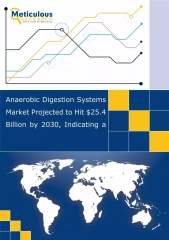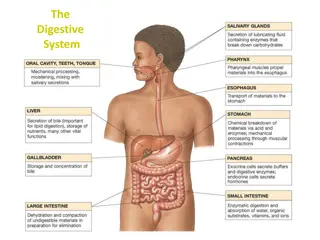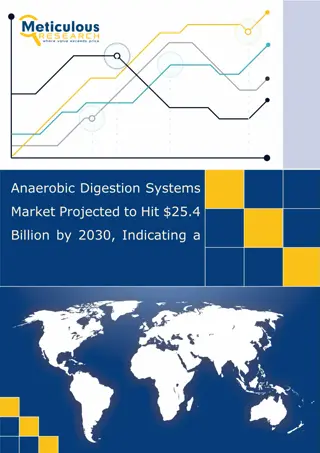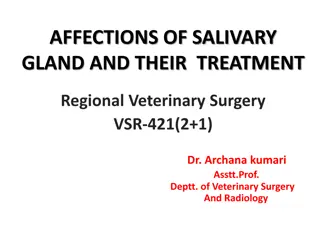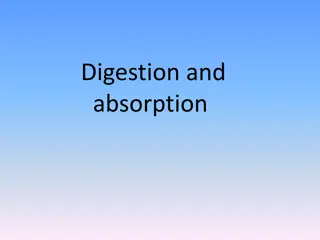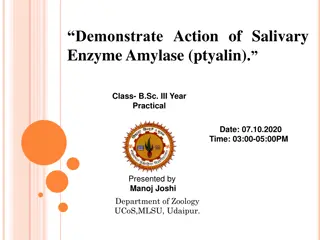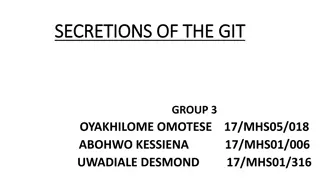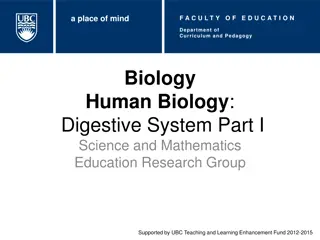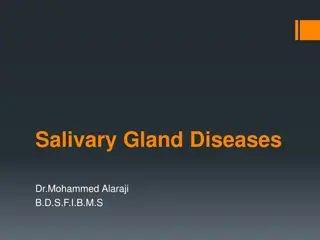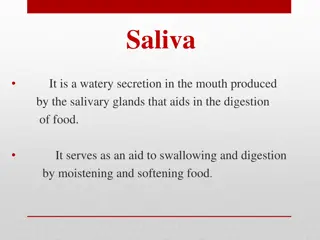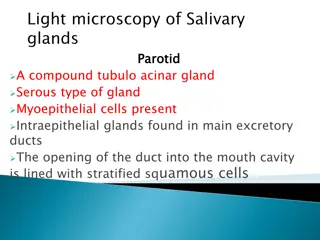
The Role of Salivary Glands and Stomach in Digestion Process
Learn about the crucial roles played by salivary glands and the stomach in the digestion of food. Explore the significance of saliva, salivary amylase, and the process of digestion, including the breakdown of carbohydrates, proteins, and fats into absorbable forms. Gain insights into the mechanical and enzymatic effects of digestion, as well as the end products of this essential metabolic process.
Download Presentation

Please find below an Image/Link to download the presentation.
The content on the website is provided AS IS for your information and personal use only. It may not be sold, licensed, or shared on other websites without obtaining consent from the author. If you encounter any issues during the download, it is possible that the publisher has removed the file from their server.
You are allowed to download the files provided on this website for personal or commercial use, subject to the condition that they are used lawfully. All files are the property of their respective owners.
The content on the website is provided AS IS for your information and personal use only. It may not be sold, licensed, or shared on other websites without obtaining consent from the author.
E N D
Presentation Transcript
Role of Salivary Glands and Stomach Role of Salivary Glands and Stomach in Digestion in Digestion By By Rana Hasanato, MD, ksfcc Clinical Biochemistry Unit, Path. Dept. College of Medicine, King Saud University
Objectives: Objectives: Understand the principle and importance of digestion of dietary foodstuffs Understand the role of salivary glands in digestion Understand the role of stomach in digestion
Background: Background: Most of dietary foodstuffs are ingested in the form that cannot be readily absorbed from the digestive tract Digestion: The breakdown of the naturally occurring foodstuffs into smaller, easily absorbable forms
Digestion: Digestion: Mechanical effects: e.g., mastication Enzymatic effects: Digestive enzymes (hydrolases)
End Products of Digestion: End Products of Digestion: Carbohydrates Monosaccharides Triacylglycerols (TAG) Fatty acids & monoacylglycerols Proteins Amino acids
Role of Salivary Glands in Digestion Role of Salivary Glands in Digestion They secrete saliva Saliva: Acts as lubricant Contains salivary -amylase Contains lingual lipase
Salivary Salivary - -Amylase Amylase Secreted by: Parotid glands Optimum pH: 6.6 6.8 Substrate: Starch and glycogen Hydrolyzes: (1,4) glycosidic bonds Produces: Short oligosaccharides
Digestion Pre-stomach Salivary amylase : 1-4 endoglycosidase G G G G G G Limit dextrins GGG G G G G G G G G amylase G G GG GGG 1-6 link G maltotriose GGG 1-4 link G G G G maltose G G isomaltose
Hydrolysis of (1,4) Glycosidic Bonds Hydrolysis of (1,4) Glycosidic Bonds
Effect of Effect of - -Amylase on Amylase on Glycogen Glycogen Hydrolysis of: (1,4) glycosidic bonds Products: Mixture of short oligosaccharides (both branched & unbranched) Disaccharides: Maltose and isomaltose
Salivary Salivary - -Amylase Amylase CONT D Its digestive action on the polysaccharides is of little significance because of the short time during which the enzyme can act on the food in the mouth Salivary amylase is inactivated by the acidity of stomach (The enzyme is inactivated at pH 4.0 or less)
Salivary Salivary - -Amylase Amylase CONT D Salivary -amylase does not hydrolyze: (1,6) glycosidic bonds (The branch points of starch and glycogen) Salivary -amylase cannot act on: (1,4) glycosidic bonds of cellulose Salivary -amylase does not hydrolyze disaccharides
Digestion of Carbohydrates in the Mouth Digestion of Carbohydrates in the Mouth
Lingual Lipase Lingual Lipase Secreted by the dorsal surface of the tongue (Ebner s glands) Acts in the stomach for the digestion of TAG Produces fatty acids and monoacylglycerols Its role is of little significance in adult humans
Role of Stomach in Digestion Role of Stomach in Digestion No further digestion of carbohydrates Lipid digestion begins by lingual and gastric lipases Protein digestion begins by pepsin and rennin
Lingual and Gastric Lipases Lingual and Gastric Lipases (Acid (Acid- -Stable Lipases) Stable Lipases) Substrate: TAG molecules, containing medium- and short-chain fatty acids; such as found in milk fat The end products are: 2-monoacylglycerols and fatty acids The role of both lipases in lipid digestion is of little significance in adult human (The lipids in the stomach is not yet emulsified. Emulsification occurs in duodenum)
Lingual and Gastric Lipases Lingual and Gastric Lipases CONT D Lipase Target substrate for acid-stable lipases is TAG containing: O O R1 C O and R3 C O as short- or medium-chain fatty acids
Lingual and Gastric Lipases Lingual and Gastric Lipases CONT D They are important in neonates and infants for the digestion of TAG of milk They are also important in patients with pancreatic insufficiency where there is absence of pancreatic lipase
Digestion of Lipids in Stomach Digestion of Lipids in Stomach In adults, no significant effects because of lack of emulsification that occurs in duodenum In neonates and infants, digestion of milk TAG and production of short- and medium-chain fatty acids
Pepsin Pepsin Secreted by chief cells of stomach as inactive proenzyme, pepsinogen Activated by HCl and autocatalytically by pepsin Acid-stable, endopeptidase Substrate: denatured dietary proteins (by HCl) End product: Smaller polypeptides
Peptide Protein Structures: Primary, Secondary, Tertiary, Quaternary
Rennin Rennin Secreted by chief cells of stomach in neonates and infants Substrate: Casein of milk (in the presence of calcium) End product: Paracasein with the formation of milk clot Effect: It prevents rapid passage of milk from stomach, allowing more time for action of pepsin on milk proteins
Digestion of Dietary Proteins in Stomach Digestion of Dietary Proteins in Stomach HCl: Denatures proteins Activates pepsin Pepsin: Cleaves proteins into polypeptides Rennin: & Rennin Formation of milk clot
Take Home Message Take Home Message Digestion involves both mechanical and enzymatic processes Digestion makes dietary foodstuffs readily absorbable by the digestive tract Salivary -amylase is of limited, but initial effect on digestion of starch and glycogen in the mouth Salivary -amylase converts starch and glycogen into short, branched oligosaccharides
Take Home Message Take Home Message CONT D Limited digestion of TAG begins in the stomach by both lingual and gastric lipases producing 2-monoacylglycerols and fatty acids Digestion of proteins begins in the stomach by pepsin producing smaller polypeptides In neonates and infants, digestion of milk occurs in stomach by: Acid-stable lipases for digestion of milk fat Rennin and pepsin for digestion of milk proteins

